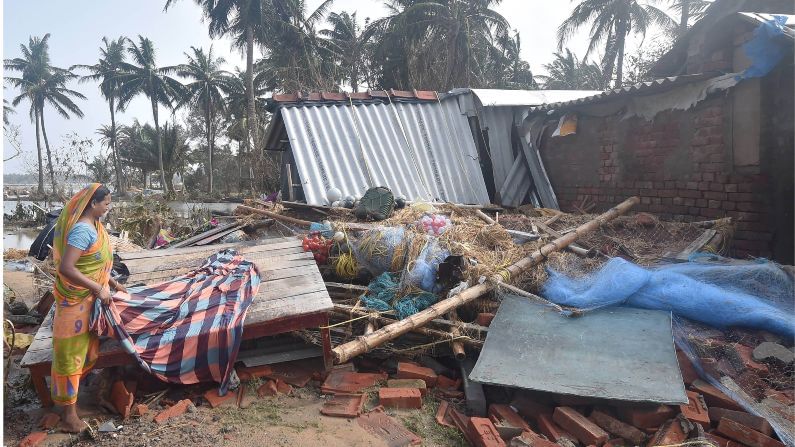Two cyclones and a pandemic: Beyond the pale of nightmares
For the first time, two natural disasters hit vast areas of the country while it was paralysed by a pandemic

Two cyclones along the two coastlines within 10 days even as a pandemic is wreaking havoc in the country form a triumvirate of simultaneous catastrophes not seen earlier in the country.
Super cyclone Tauktae that made a landfall in Gujarat on May 17 was the most severe to lash the state since the storm in 1998.
Just nine days later, on May 26, cyclone Yash battered Odisha, West Bengal and Jharkhand, all the states already being under pandemic-triggered lockdowns or near-lockdown restrictions.
Any economic disruption in the midst of pandemic poses extreme challenge for any government and the people, and a couple of them goes beyond nightmarish proportions.
Damage unlimited
Thanks to early warning systems that can predict cyclones even seven days in advance, the number of fatalities in such natural calamities have come down drastically, but the damage to property can’t be contained as crops standing the field, or fertility of land can be severely impacted in storm surges, houses topple by thousands, electric poles and communication towers fall like nine pins, orchards stand decimated besides the death of some livestock too.
Brackish bane
The coastal areas of West Bengal and Odisha are dotted with fisheries. The fish in most of them have died after saline water flowed in following the storm surge.
Many farmlands along the coastline have been rendered unfit for cultivation for years after they were inundated with saline water.
Even mass evacuation is expensive. To guard against Yash, Odisha government moved 5.8 lakh people and more densely-populated Bengal evacuated 15 lakh in face of the cyclone.
Relief, rebuild
The government has to provide relief materials, ration for some days as well as rebuild public infrastructure. At a time when the revenues of the government is down and there is huge build-up of debt, even small expenditure adds to the burden.
In its research report on the Indian economy Ecowrap, State Bank of India said in March that the combined fiscal deficit of the Centre and the states would stand around 12.7% of GDP in FY21 on account of fall in revenue and rising expenditure due to the pandemic.
Curtailing expenditure
The cyclones would add to the burden of the state exchequer at a time when they were curtailing expenditure to tide over the financial hardship.
The SBI report said that states curtailed expenditure in FY21 budget by as much as 11.3% compared to what they stated in the budget estimates for the year to compensate for the fall in revenue from a variety of sources including GST.
Interim relief
On May 19, after a survey of his home state, Prime Minister Narendra Modi declared an immediate grant of Rs 1,000 crore for Gujarat as immediate relief.
A team would study the impact and ascertain the quantum of damage in Gujarat and other states according to standard practice.
Media reports suggested Gujarat has suffered damages of at least Rs 3,000 crore. The impact to the electricity network is roughly estimated around Rs 1,400 crore and that to the farm sector more than Rs 1,200 crore as mango, banana and coconut plantations have been ruined.
On May 28, Prime Minister Narendra Modi announced another cumulative interim relief of Rs 1,000 crore for Odisha (Rs 500 crore), West Bengal and Jharkhand (Rs 250 crore each).
Long-term help
Odisha Chief Minister Naveen Patnaik valiantly said that his government would try to provide relief and rebuild facilities with their own finances, but the state, which is an unfortunate favourite of cyclones, appears to have sustained immense damage that would take years to rebuild.
According to its economic survey, Odisha has suffered a contraction of 4.92% in its gross state domestic product in FY21 due to the pandemic.
“We demanded two long-term solutions. One is disaster resilient power system and another is coastal storm surge protection. We did not seek any relief package from the PM at the review meeting,” special relief commissioner PK Jena told media.
On May 28, Mamata Banerjee handed over a letter seeking a compensation of Rs 20,000 crore, an amount which is 57% of the Rs 35,000 crore that the Centre announced in the FY22 budget for vaccine preparedness for the entire year.
“I have received reports of huge damage and devastation from the government officials from the affected districts. Big damage has been reported touching around Rs 20,000 crore. I have sought a package worth Rs 20,000 crore, with Rs 10,000 crore each for rehabilitation and rebuilding of Digha and Sundarbans,” said Mamata Banerjee on Friday.
Amphan’s impact
Three lakh houses were damaged in the cyclone, the Bengal chief minister said earlier.
Incidentally, the Bengal government accessed the quantum of damage by cyclone Amphan that hit Bengal directly on May 20, 2020 during the nationwide lockdown at more than Rs 1 lakh crore.